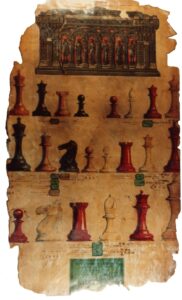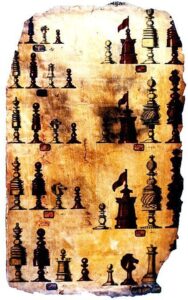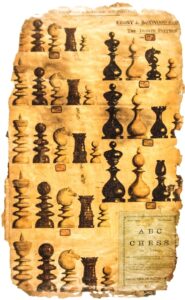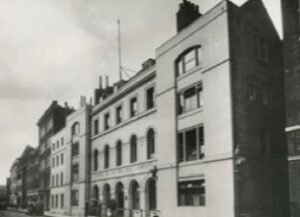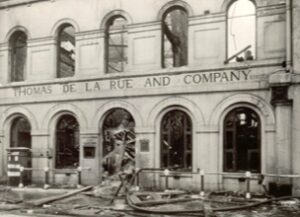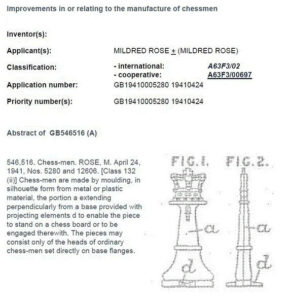In England, or better the British Islands, you find the most variety in types/patterns. They are sometimes called after a town or a famous maker or it’s workshop. This does not always mean that the set was actually made in that town or by that workshop. In many cases the type was made by others as well. Sometimes a reference is made to a famous person or a chess club.
John Calvert worked from 1791 until his death in 1822, after which his widow Dorothy took over until her death in 1840. He is one of the top chess set makers, well known of his beautiful Knights. His "CALVERT 189 FLEET STT" stamp may be found on sets (on Rooks) or boxes.
This very early set, in signed box, is historically interesting because the Knights are in the 18th century manner instead of the later carved Knights. The long thread that connects the head to the stem is also seldom seen. Normally, Knights in such sets are monoblock or connected with a pin.
It is almost certain that the wooden set has been made by Calvert, although it is not signed and came with a box in which St.George sets of presumably Jaques are seen. Most remarkable are the exceptionally well carved Knights, which are made of one piece of wood here. A feature seldom seen in wooden "St.George" type sets.
There exists a flower pattern which is called the "Calvert" type, which is made by many. See Jaques for an example.
- England, by Calvert
- 18th-19th century
- Ivory K 9.7; p 4.1
- Box 16.5×12.2×6.8
- Box signed "CALVERT 189 FLEET STT"
- England, by Calvert? "St.George"
- 1st half 19th century
- Boxwood + rosewood K 9.3; p 4.7
- Box presumably by Jaques 22.1×14.5×7.1
- Knights are made of one piece of wood!
George Merrifield is maybe the best turner of his time. His chess sets are outstanding in precision and beauty. As far as I know are all "Merrifield" sets actually made by George Merrifield and not by other manufacturers. George Merrifield worked from about 1819 till his dead in 1855.
- England, by George Merrifield
- Early to mid 19th century
- Ivory K 8.9; p 4.0
- Box 22.8×10.5×6.6
- England, by George Merrifield, "St.George" (pegged)
- Early to mid 19th century
- Ivory K 4.2; p 2.3
"Lund" type sets are called after chess sets made by father Thomas (at 56-57 Cornhill, London from 1804 until his death in 1843) and son William (at 24-25 Fleet Street, London from 1835 until his dead in 1872). We have seen signed sets of both. William took his father's running as well. His son Charles continued the business under the name of William Lund & Son. This type was very popular and has been made by several manufacturers. This particular set is larger, more chunky and has more discs on the pieces as usual.
- England, "Lund"
- Mid 19th century
- Ivory K 11,7; p 5.5
"Lund/Fisher" type chess sets are recognized by the open worked crowns of the King and Queen. Typically these sets are of large size. The box of this set is narrow and high, which could be the original box. Sorry, I have no picture of the box yet. The sets were most likely made in William Lund's workshop, although there are sets signed by Fisher. Fisher could have made these sets, but see also the section on Fisher itself.
- England, "Lund/Fisher"
- Mid 19th century
- Ivory K 12.5; p 4.9
- Box 23.9×10.9×15.9 (not pictured)
"Fisher" This travel set could very well have been made by Samuel Fisher. Collector Holger Langer describes a very similar set which is signed "Fisher" and "188 Strand". That's not a proof he made it, the sign could well have made on his demand. Samuel Fisher first shows up in the London directories in 1839 as a dressing case maker, and continued through at least 1899. From 1853 onwards he is listed with the address "188 & 189 Strand". In 1882 the listings changed to Fisher & Son. Although it is generally assumed that Fisher was solely a retailer, he is also listed as an Ivory Turner in the 1865 and 1869 trade directories.
- England, by Samuel Fisher? "St.George"
- Mid 19th century (sold as 1900)
- Bone K 3.3; p 1.6
- Box/board 15.3×7.7×2.8
(John) Jaques of London is probably the most successful maker. At least longest existing, from 1795 till the present day, and run by the 8th generation now. Most famous, of course, is the "Staunton" pattern, which was patented on March 1, 1849, by Nathaniel Cooke, 198 Strand, London.
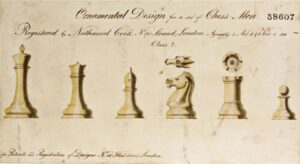
John and Nathaniel were related by the marriage of John's son John (II) with Nathaniel's daughter Harriet Ingram. Nathaniel was editor of "The Illustrated London News" (1842-2003), founded by his brother in law Herbert Ingram. That paper contained a chess column by Howard Staunton, who was asked by Cooke to advertise the chess set. He did so in his column on 8 September 1849 for the 1st time. As far as I know, Howard Staunton was the 1st sportsman to give his name to a product. It is not certain who is the designer of the Staunton pattern. It is not Staunton and probably also not Cooke. Most likely did John Jaques attribute to the design.
The codex of Frank Camaratta is an attempt to classify Jaques Staunton sets and the names "Anderssen" and "Broadbent" are from that codex and not names given by the Jaques of London company. The codex, however, is far from 100% decisive and Staunton connoisseur Alan Fersht did not use it in the 2nd version of his book. However, he is still using it at his website.
- England, by Jaques, "Staunton" ("late Anderssen")
- ca. 1870
- Boxwood + ebony K 7.4; p 3.7
- Box 16.0×11.6×6.8
- England, by Jaques, "Staunton" ("Broadbent")
- ca. 1935
- Boxwood + ebony K 9.7; p 5.3
- Box 21.8×16.8×10.8
Next to "Staunton", a lot of other chess set patterns is found in Jaques famous pattern book: "Barleycorn", "Calvert type", "Dublin", "Edinboro Upright", "St.George", etc. Jaques did invent and make a whole lot of other type of games as well. Below a few pages from their famous pattern book, what they are a bit mysterious about.
- England, by Jaques, "No. 24"
- Early to mid 19th century
- Bone K 13.6; p 4.9
- England, by (most likely) Jaques, "Calvert"
- ca. 1840
- Ivory K 8.4; p 3.9
- Box 16.5×12.4×8.0
Jaques made travel sets of the "Whittington" type in sizes of 6-8-10-12 inch. I have several Whittington sets, but none are signed. See Travel (England) page for Whittington type examples.
Jaques made these "In Statu Quo" chess sets in different forms. There exists also a larger version. This one is an early example, with places for captured pieces, which dates it from 1857 onwards. The pieces are ivory, which was an option I believe. By default they were made of bone. That this is an early set, around 1860, can be seen at the very thin pins that easily bend if you lock the pieces while not completely down. Maybe that is the reason that Jaques switched to pieces with significantly thicker pins. Also the holes in the board are smaller, because I noticed that pieces with the thicker pins don't fit well and only can be placed with brute force.
- England, by Jaques, "In Statu Quo"
- ca. 1860
- Ivory K 1.4; p 1.3 (without pins)
- Board 23.0×29.5×2.9 (open)
- Slipcase 15.9×23.9×7.2
F.H.Ayres. The business and factory of Frederick Henry Ayres, manufacturer, was started 1864 and from 1865 located at 10 Baldwin’s Place, Leather Lane, London EC, then from 1869 at 71 to 75 Red Lion Street, Clerkenwell and finally from 1877 at 111 Aldersgate Street, London, EC. It became F.H.Ayres Ltd. c1905 (known mainly for outdoor games). Later taken over by Slazenger (c1948).
F.H.Ayres made a range of different sets. Here some examples. Other F.H.Ayres examples can be found at “Barleycorn” and Slim-playing pages.
- England, by F.H.Ayres, "Dublin/St.George influenced"
- ca. 1900
- Tagua nut (vegatable ivory) K 8.6; p 4.3
- England, by F.H.Ayres, "Staunton"
- ca. 1930
- Catalin K 7.6; p 3.5
- Box 18.2×13.3×6.8
- England, by F.H.Ayres
- ca. 1930
- Plastic (Galalith?) 1.3 (1.9 with pin)
- Board 16.5×16.3×0.8
- Box signed "Ayres REG." 10.5×18.8×4.7
Asser & Sherwin, makers, 81 Strand, London. Grandfather Thomas Sherwin (1776-1863) was originally a bookbinder, but became a backgammon table and chess board manufacturer in about 1820. Father Thomas Sherwin (1802-1881) was also a dealer in games. Charles Sheppard Sherwin (1833-1872) formed in 1860 a partnership with his cousin James Asser (1836-1924) - 'Asser&Sherwin'. They traded until 1882 (despite the death of Charles Sherwin in 1872) at premises at 80-81 Strand and Oxford Street, selling travel goods, 'fancies', games and sporting equipment. Charles death certificate describes him as a Bagatelle Board Maker. On the closure of the company James Asser went on to found Turnbull and Asser the Jermyn Street shirtmakers. Recently (Sep. 2020) I found a lid of a box with their logo. I have only the lid and no box. Also don't know what was in the box originally.
- ASSER&SHERWIN
- MAKERS
- 81 STRAND.LONDON
Thomas De La Rue 1st commercial venture was a newspaper on Guersney in 1813, but moved the printing business to London in 1821. In 1831 the company started to make playing cards, a division sold to John Waddington in 1969! In 1855 it started to print postage stamps and in 1860 banknotes (for Mauritius). In 1874 they opened a new factory in Bunhill Row, London. In 1881 they entered the pen market. In 1898 the family partnership structure changed to a private company and the De La Rue family left the business and the company became publicly owned. Today their main business is currency and authentication. On De La Rue site is a lot more of information.
De La RUE factory at Bunhill Row opened in 1874 and demolished on September 11th 1940
The name on the building is: "THOMAS DE LA RUE AND COMPANY". Pictures are unclear, but 2nd one seems to show a small "Limited". I could not find out if "Limited" was added in the period between the 2 pictures or was there from the beginning.
Of interest to us are their Wallet sets and Stud sets. Such stud set has a clamp which can have different inscriptions: "TDLR", "TdLR" or "DLRLd". "Thomas De La Rue" or "De La Rue Limited", I think. In 1958 the company dropped Thomas in their name. Question is whether these sets could have been made after 1958 as well ? I have been told that's not the case.
De La Rue wallet set and stud set.
The origins of B&Co. are unclear and research didn't reveal much. What can be determined, based on the style of the chessmen and their boxes is that B&Co. started producing Staunton chessmen in the mid to late 1850s. Stampings are found on their extremely scarce, but beautiful, "Regulation Chessmen" which come in signed box. Specific is that bases are made separately and are screwed. We see that on ivory and bone sets, but rarely on wooden "Staunton" sets. Note the King without cross. B&Co. sets are rare.
- England, by B&Co. London, "Staunton"
- Mid to late 19th century
- Boxwood + ebony K 7.4; p 4.0
There are a lot of other makers or retailers, like Asprey, J.Barr, BCC (founded by W. Moffat and W. Hughes, making chessmen from 1891 to about 1907, well known by the use of Xylonite, a celluloid), H.Dixon, W.Hallet, C.Hastilow, W.Howard, W.Leuchars (probably the 1st retailer of Jaques Staunton sets), Wedgwood, R.Whitty, to name a few older ones. I do not have examples of all of these makers/retailers, but you can find some of them elsewhere on my site.
Here some "Staunton" sets of unknown makers. The large 41/3" (11.1cm) ivory set is a beautiful set, but it's origin is unclear. Someone has crudely marked or re-marked the crowns and Jaques signature. Frank Camaratta, at Oxford CCI meeting in 2024, closely looked at the pictures but wasn't sure. Frank could only tell for sure if he saw the pieces itself, which could only done at my home because I cannot take them abroad. On the other hand, Jaques made ivory sets in this size where Rooks are a bit taller than Knights, as is in this set. Unfortunately does one white Knight miss a little piece of its jaw. The box is not a chess box, I think, and is not in best condition. The 32/3" (9.3cm) bone set is extremely scarce. It is very much rarer as wooden ones, and even more rare as the ivory ones, especially in this size which is large for a bone set. Beautiful Knights as well. I think the box it came in is original. The 21/2" (6.5cm) small wooden set is also of an unknown maker, but is not that uncommon. Note the King without cross.
- England, by Jaques? "Staunton"
- Mid to late 19th century
- Ivory K 11.1; p 4.7
- Box pp.p×qq.q×r.r
- England, "Staunton"
- Mid to late 19th century
- Bone K 9.3; p 4.3
- Original box 15.9×11.2×8.0
- England, "Staunton"
- Late 19th century
- Boxwood + ebony K 6.5; p 3.5
20th century makers Mildred Rose and Britain made lead sets based on the "Staunton" design. You find them on "The Rose Chess" and Britain pages. A set from K&C Ltd. in London is not in the collection. On the Plastic page more "Staunton" sets of manufacturers like Grays of Cambridge, Chad Valley and House Martin. Some of unknown makers as well. On the latter page is a very rare plastic travel set by F.H.Ayres as well (see also Travel (England)).
England. I call this set "Old English". However this name is also used for sets better known as "St.George". Actually, there is no common accepted naming convention for sets like these. Maybe because these sets are extremely rare.
- England, "Old English"
- 1st half 18th century
- Ivory K 6.9; p 3.5
England. The "George Washington" sets are called that way, because George Washington did own a set that is similar. Typical characteristics are urn shapes in stems/finials, small mitres on Bishops, high arched Knights and Rooks tapered in one line and with brickwork. The 1st set is identical to the set in Liddell's book. Note that the 3rd set has atypical Rooks. Maybe that set dates early 19th century.
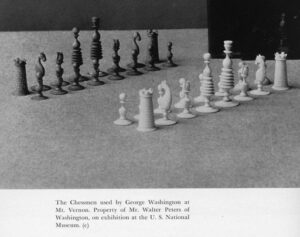
- England, "George Washington"
- Late 18th century
- Ivory K 8.6; p 3.6
- England, "George Washington"
- Late 18th century
- Bone K 8.5; p 4.0
- Box 16.7×11.3×7.3
- England, "George Washington"
- Late 18th century
- Bone K 10.7; p 4.6
England. These "Spiked" sets were made in the 18th century, but I'm not sure when the production stopped. Probably early 19th century. They exist in a wide variety. This set is a nice example of one of the later sets of this type. I do not know whether "Spiked" is an official name for this type, but it describes it best.
- England, "Spiked"
- 18th-19th century
- Bone K 7.8; p 3.5
England. The "Calvert" type, with flower design, would trace back to 15th century German designs, but I'm not sure about that. The sets are often wrongly attributed to John Calvert, who is not the only maker. Other well known makers of the type are George Merrifield, Thomas Lund and John Jaques, most likely the maker of this set. Note that other type sets made by John Calvert are also called "Calvert". See English makers page.
- England, by (most likely) Jaques, "Calvert"
- ca. 1840
- Ivory K 8.4; p 3.9
England. This cute little "Dublin" set was obtained Oct. 2019 and is rather new in my collection. This type is hard to find and normally not this small. Condition however is excellent and it has a box which is most likely original. Unfortunately an unknown maker, but it is one of my favourites.
The vegetable ivory set has a certain "Dublin" influence, as well as some "St.George". The vegetable ivory of this set is actually the inner part of the Tagua nut found in South America. Until today it is used for all kinds of objects such as chess sets, buttons, figurines and jewellery.
- England, "Dublin"
- Mid 19th century
- Boxwood + ebony K 6.0; p 3.5
- Box 15.2×10.0×5.5
- England, by F.H.Ayres, "Dublin/St.George influenced"
- ca. 1900
- Tagua nut (vegatable ivory) K 8.6; p 4.3
England. This set is called "Upright". These attractive sets were designed for the Edinburgh chess club by Lord Jon Hay in the 1840’s. Jaques made sets called "Edinboro Upright", but they are also referred to as "Northern Upright".
The 2nd set listed here is not in the traditional "Upright" manner, but mostly called so. One can certainly say it is "Upright inspired". Dating is also disputable: some say early 19th century, but others say late 19th century. I tend to believe the later dating. This form exists also fully decorated.
- England, "Upright"
- Mid 19th century
- Boxwood + ebony K 8.3; p 4.4
- England, "Upright inspired"
- Late (or early?) 19th century
- Bone K 8.4; p 4.5
England. The name of "St.George" sets is derived from the London's chess club "St.George", where these kind of figures were used. They are definitely the most widespread type of sets in Britain, apart from the later Staunton sets.
Here some examples of British "St.George" sets. These are often called "Old English" as well, but in my opinion that name is better to reserve for the English designs of the 18th century.
The 1st set is almost certainly made by Calvert, although it is not signed and came with a box in which St.George sets of presumably Jaques are seen. It is one of my favourites because of the most beautiful Knights I have seen on English sets of this type. The Knights are made in one piece, which is rare in this kind of set.
The following other 6 sets are more common sets of unknown makers. Set nr.4 has a bishop and pawn replaced, while set nr.5 has an extra black pawn! Maybe the last has been made by Jaques?
- England, by Calvert? "St.George"
- 1st half 19th century
- Boxwood + rosewood K 9.3; p 4.7
- Box presumably by Jaques 22.1×14.5×7.1
- Knights are made of one piece of wood!
- England, "St.George"
- Mid 19th century
- Boxwood + rosewood K 9.1; p 3.9
- England, "St.George"
- Mid 19th century
- Boxwood + rosewood K 9.5
- England, "St.George"
- 2nd half 19th century
- Boxwood + ebony K 7.9; p 3.5
- England, "St.George"
- 19th century
- Boxwood + ebony K 9.2; p 3.9
- England, "St.George"
- 19th century
- Boxwood + ebony K 10.6; p 4.3
- Engeland, by Jaques? "St. George"
- Early 20th century (or earlier?)
- Boxwood K 8.5; p 3.6
England. The "slope Knight" set is in fact a cheaper variant of the "St. George" pattern as no cutting is required apart from some simple incisions.
- England, "St.George with slope knights"
- ca. 1900
- Boxwood + rosewood K 5.6; p 2.4
- Original box 11.8×8.5×4.8
England. You see the "st.George" pattern also in travel sets. These are pieces of a set by Merrifield. It lacks a board, so it is hard to tell what type it was, but I think it was most likely of the "Railway" type. Pieces of this set were offered at Ebay in several lots as spare pieces. I asked the seller to extract the Merrifield pieces, what he did. 2 red pawns were missing and have been remade by a professional chess set restorer.
- England, by George Merrifield, "St.George" (pegged)
- Early 19th century
- Ivory K 4.2; p 2.3
England. I got information that such travel sets were sold under the name "THE TRAVELLERS' CHESS BOARD, WITH CHESS MEN COMPLETE." by W.H.Smith & Son, 136, Strand, London in their bookstores at train stations. W.H.Smith were sellers of a wide range of goods at railway stations from the late 1840's. It's believed that the sets were made over a long period and the turned pieces changed in later years. Holger Langer lists a similar set signed by Samuel Fisher, 188 Strand. Although the latter has a folding board, but with same leatherette and decoration. The pieces are almost identical, only the lower collar of the king and queen differs.
- England, by Samuel Fisher? "St.George"
- Mid 19th century (sold as 1900)
- Bone K 3.3; p 1.6
- Box/board 15.3×7.7×2.8
England. This vegetable ivory set has a certain "Dublin" influence, as well as some "St.George". The vegetable ivory of this set is actually the inner part of the Tagua nut found in South America. Until today it is used for all kinds of objects such as chess sets, buttons, figurines and jewellery.
- England, by F.H.Ayres, "Dublin/St.George influenced"
- ca. 1900
- Tagua nut (vegatable ivory) K 8.6; p 4.3
Very often sets are wrongly called "Barleycorn": 1. Ornamental sets with other motives, like leaves, an acanthus motive, or the very rare "Ropetwist" sets. 2. Undecorated sets where King and Queen have a fat barrel (mostly ribbed), the Rook is fat without stem but with finial and often a flag, the Bishop has a deep slit and the Knight is round. 3. Undecorated slim sets. 4. German "Nuremberg" sets of similar overall shape, but their Bishop with a small or absent slit, a simple slim Knight and bases much smaller as their English counterparts. 5. German decorated types (sometimes with faces). 6. German (or some say Dutch) decorated type where King and Queen lack a stem. 7. German type with open worked barrels of King and Queen. Although the latter 2 are not very often seen as "Barleycorn".
England. The essence, or origin, for the name of these ornamental sets is the decoration with the grain. Sometimes combined with other motives. The type has been made from ca. 1820 onwards. The end is less clear: certainly till a bit after mid 19th century (the F.H.Ayres set is made after 1864) and possibly till end of 19th. It was thought that the technique for the decoration was introduced by the so called Holtzapffel lathe, but that can only create some specific numbers of corn repetitions and we count non-matching numbers. A discovery by restorer Alan Dewey.
The decoration is only applied to King and Queen. Rook is rarely decorated, and then usually with a different motive. Bishop has a deep slit and the Knight is round. Bases are round and "cogged" usually. The fanciest bases are called Van Dyke bases. Most sets have "reeded" balls on Queen, Rook and pawn. The pattern applied to Bishops as well.
"Barleycorn" sets are mainly made of bone, but ivory sets do exist as well. Rooks in ivory sets may have a stem. English wooden "Barleycorn" sets may not exist.
- England, "Barleycorn"
- Early to mid 19th century
- Bone K 10.0; p 4.1
- England, by F.H.Ayres, "Barleycorn"
- 2nd half 19th century
- Bone K 13.3; p 4.7
England. It is very common to call the Jaques No.24 set a "Barleycorn", but that's not correct because there is no real barleycorn grain motive. However, there are some leaves. There is a kind of ropetwist decoration, that looks more as bicycle gears, on the barrel. But it is not a "ropetwist" set either. These sets come with some little variations of he pearl decoration: 1. on barrel only 2. on barrel and upper collar (as in this set) 3. on barrel, upper collar and disk above the ball in the stem.
- England, by Jaques, "No. 24"
- Early to mid 19th century
- Bone K 13.6; p 4.9
England. This set is a "Ropetwist" set, called so because of the decoration that simulates a twisted rope. In this set at the upper and lower side of the central drum of the King and Queen. Sometimes it is on rooks as well. Very often the name is, in my opinion mistakenly, used for ordinary plain bone sets which have a central drum looking like a coiled rope. On the other hand "Ropetwist" sets aren't recognized always as such and sometimes wrongly called "Barleycorn". I think these sets are extremely scarce. I have seen only a couple of them.
- England, "Ropetwist"
- Mid 19th century
- Bone (or ivory?) K 9.3; p 3.4
- Box (chinese!) 13.8×11.4×9.1
England. Next plain bone sets are often incorrectly called "Barleycorn" sets. And I used to call them "plain Barleycorn". Now I have concluded that it is better to indicate them as "plain bone" or maybe "ribbed bone" sets, although the latter is not for all sets applicable, like the last one in this series.
Note that the overall shape is like "Barleycorn" sets: big barrels, big rooks with finial and often a flag, round knights and bishops with a deep slit. These sets are very common, except that the last set of the four has a less common pattern. In black they are very uncommon, but the black set here has been painted later on and was originally red.
- England, by Jaques?
- Mid 19th century
- Bone K 9.0; p 3.4
- England, by F.H.Ayres
- 2nd half 19th century
- Bone K 12.1; p 4.5
- England, by F.H.Ayres
- 2nd half 19th century
- Bone (repainted black) K 11.1; p 4.1
- England
- ca. 1860
- Bone K 9.3; p 3.8
- Box 17.7×11.4×9.5
- England
- 18th-19th century
- Ivory K 8.6; p 3.8
- England, composed set
- ca. 1830
- Ivory K 8.2; p 3.6
- England
- 1st half 19th century
- Ivory K 12.2; p 4.4
- England
- Mid 19th century
- Ivory K 8.6; p 3.5
- England
- ca. 1860
- Ivory K 7.8; p 3.3
- Box 19.5×12.4×7.5
- England
- ca. 1870
- Ivory K 8.7; p 3.7
“Staunton” sets are not repeated here, but are at makers and plastic sections of this page.
England. "The Rose Chess" was patented on 24 April 1941 by The Rose Chess company of Mrs Mildred Rose of Rofant Road, Northwood, Middlesex. The lead pieces, based on the Staunton design (named "ordinary chess-men" in the patent), are flat with supports at the base for stability. Picture below of (part of?) the patent is copied from "chess-collection.de".
According Dennis Hunt, in an article called “My life (so far) as a collector” In USA-News – Chess Collectors International – Vol.8,no.3 (October 2001), does the patent describe an associated board in which the pieces do fit and can be secured by turning. It is hard to believe because it would ask for a construction in the board, on each field, that makes it possible. I have never seen such associated board. It isn't mentioned in the patent above either. But maybe above extract isn't complete.
Some say that the design was by W.B.Tattersall, London. I have my doubts about that. Tattersall is a.o. known for their series small booklets with game rules. Not only chess. Often the chess booklet is offered together with "The Rose Chess" set. I could not find proof he did design "The Rose Chess" set.
There are boxes in 3 sizes, labels in 3 variants, 2 different patent numbers, large and small sets. You see large sets in large boxes, large and small sets in medium boxes and small sets in small boxes. But I have to say that I'm not sure whether a small set in a medium box is an original combination.
There is one label variant, which is extremely scarce. I bought one in 2011 and August 2018 I saw another which I bought as well (sic). It is a large set in the medium box with label stating, "THE" and "Rose Chess" in 2 straight lines, "( Prov. Patent 5280/41 )" and "MADE IN ENGLAND". The facts that there is "/41" at the patent and that there is no "NO. 1 SET" on the label suggest that we deal with a very early set from 1941. Also all pieces are stamped "MADE IN ENGLAND" only and omit the other stamps.
Large and medium boxes normally have a label stating: "THE ROSE CHESS" in bended way, "PROV. PAT.No 5280", "MADE IN ENGLAND" and "NO. 1 SET". Small boxes have a label stating: "THE ROSE" and "CHESS" in 2 straight lines and "PATENT NO 546516". Pieces are stamped with "ROSE", "MADE IN"+"ENGLAND" and "P/PAT.5280", although not always very well visible or consistent. It is also striking that the small pawns in a medium box have been stamped, unlike the pawns of sets in the small box. On the other hand, they did small pieces stamped "P/PAT 5280" in a box labelled "PATENT NO 546516" as well. That isn't consistent 😉
The "NO. 1 SET" indication could have been introduced when the smaller set came out. The small set in small box does not have a classification. Probably it is a kind of quality indication (as is "de luxe" nowadays) or referring to original/best quality. It doesn't match with a small set in a medium box with "NO. 1 SET" on it, which strengths my opinion today that this is not an original combination.
Al last: The colour of the large set in the large box tends to be a bit more orange and less shining than the red/black of the others. Sometimes you see other colours, like cream with black. Not sure that's original. Boxes can have other colours as well, like green. The box of the last set in this series does have staples at the side, which is less common, as well as the fact that none of the pieces have been stamped.
"The Rose Chess" set is very common and can be found on eBay on a weekly base. Often dated to 1900-1920, which of course is wrong.
This set from 1941 is one of two I have seen.
- England, "The Rose Chess"
- 1941
- Lead K 6.4; p 3.0
- Box 11.0×9.0×3.8
- Large "Rose" model in medium sized box with:
"Prov. Patent 5280/41" - All pieces stamped at bottom with just "MADE IN"+"ENGLAND" (in 1 or 2 lines)
This set from 1941 is the other one I have seen.
- England, "The Rose Chess"
- 1941
- Lead K 6.4; p 3.0
- Box 11.0×9.0×3.8
- Large "Rose" model in medium sized box with:
"Prov. Patent 5280/41" - All pieces stamped at bottom with just "MADE IN"+"ENGLAND" (in 1 or 2 lines)
- England, "The Rose Chess"
- ca. 1942
- Lead K 6.4; p 3.0
- Box 17.8×11.7×3.6
- Large "Rose" model in large sized box with:
"PROV. PAT.No 5280" and "NO. 1 SET" - All pieces stamped at bottom with (parts of) "ROSE", "MADE IN"+"ENGLAND" (in 1 or 2 lines) and "P/PAT.5280"
Note that the pieces are still originally bound to their cards!
- England, "The Rose Chess"
- ca. 1942
- Lead K 6.4; p 3.0
- Box 17.8×11.7×3.6
- Large "Rose" model in large sized box with:
"PROV. PAT.No 5280" and "NO. 1 SET" - All pieces stamped at bottom with (parts of) "ROSE", "MADE IN"+"ENGLAND" (in 1 or 2 lines) and "P/PAT.5280"
- England, "The Rose Chess"
- ca. 1942
- Lead K 5.1; p 2.8
- Box 11.0×9.0×3.8
- Small "Rose" model in medium sized box with:
"PROV. PAT.No 5280" and "NO. 1 SET" - All pieces stamped at bottom with (parts of) "ROSE", "MADE IN ENGLAND" (in 1 line only) and "P/PAT.5280"
Note that the pieces are still wrapped in original paper!
- England, "The Rose Chess"
- ca. 1942
- Lead K 5.1; p 2.8
- Box 10.8×7.1×3.4
- Small "Rose" model in small sized box with:
"PATENT No 546516" - Most major pieces (pawns not) stamped at bottom with (parts of) "ROSE", "MADE IN ENGLAND" and "P/PAT.5280" !!
- England, "The Rose Chess"
- ca. 1942
- Lead K 5.1; p 2.8
- Box 10.8×7.1×3.4
- Small "Rose" model in small sized box with: "PATENT No 546516"
- Most major pieces (pawns not) stamped at bottom with (parts of) "ROSE", "MADE IN ENGLAND" and "P/PAT.5280" !!
- England, "The Rose Chess"
- ca. 1943
- Lead K 5.1; p 2.8
- Box 11.1×7.6×3.4
- Small "Rose" model in small sized box with: "PATENT No 546516"
- None of the pieces stamped at bottom.
England. I do not believe that the more Staunton looking variant, which is rather scarce, is made by Mildred Rose, because pieces are not stamped and the box, that appeared with such set on September 2017, has no label or other indication. The box is like the large box of The Rose Chess, including small inner box (fixed this time), but of inferior quality. If it was from Mildred Rose you would expect a label or stamped pieces. So I think the more Staunton looking variant is a cheaper copy of The Rose Chess from another source. In different pattern to avoid patent problems, maybe?
- England, "Staunton" (in Rose Chess manner)
- ca. 1942
- Lead K 6.4; p 2.9
- Pieces not stamped
- England, "Staunton" (in Rose Chess manner)
- ca. 1942
- Lead K 6.4; p 2.9
- Box 18.0x11.7x3.4
- Pieces not stamped
England. Lead chess set, made by Britain around WWII, based on the Staunton design. I do not know much of it, but these sets were sold in large presentation boxes as well as simple cardboard boxes (mostly with blue lid). Unfortunately I have only one set pieces and no boxes.
- England, by Britain, "Staunton"
- ca. 1940
- Lead K 5.0; p 2.9
Plastic sets are ignored by most collectors. I think that is unjustified. BCC sets in Xylonite, or the wooden with Xylonite knight heads, are very collectable. Unfortunately I do not have it in my collection.
Bakelite disc sets, like "The Services Set", can be found in Symbols and figurines page.
England. Here are Galalith and Catalin sets in the "Staunton" design, which are quite old and interesting. Galalith and Catalin are old plastics which hardly, if at all, have been produced after WWII. Galalith could not be formed in moulds, so the pieces are turned and carved by hand. Catalin required every piece being individually cast and polished, which became too expensive at the end of WWII.
The first set is a Galalith one. It is interesting, because the board can be folded and put over the box in order to close it. There is a difficult to read logo at the closing flap of the board. There are, in a circle, a big combined "R" and "M", another big "M" and "URIE" as well as the word "PATENT". Below the circle it states "APP.FOR". I'm not sure what it means, but it could be RM Murie, maybe the manufacturer, but that is a name unknown to me. It is assumed that Uhlig made the pieces, because they are exactly designed as Uhlig sets like the bone "Staunton".
The second set is a Catalin one and made by F.H.Ayres. We know the latter, because of equal sets in a cassette with the F.H.Ayres logo. However these pieces have characteristics of the Uhlig sets. Maybe the pieces were made by Uhlig as well.
- England, "Staunton"
- ca. 1920
- Galalith K 5.7; p 2.9
- Box 14.0×7.5×7.2
- Board 26.7(31.7)×25.9
- Pieces are probably made by Uhlig
- England, by F.H.Ayres, "Staunton"
- ca. 1930
- Catalin K 7.6; p 3.5
- Box 18.2×13.3×6.8
England. The "Grays of Cambridge Silette Chess" in Catalin is based on "Staunton". This version has screws inside, but there exist also a version with pin hole connection. I have seen a set in a carton box as well, but I'm not sure that was original.
- England, by Grays of Cambridge, "Silette Chess"
- ca. 1935
- Catalin K 6.2; p 3.4
- Box 17.0×9.4×6.7
England. A cheap, hollow plastic "Staunton" set by The Chad Valley Co. Ltd. with a very well survived box.
- England, by Chad Valley, "Staunton"
- ca. 1950
- Plastic K 7.0; p 3.9
- Box 15.3×13.7×5.0
England. Even plastic sets from the 50ies are interesting, as this set with accompanying box proves. It is made of acrylic, or acrylic glass, know under brand names like Perspex or Plexiglass. Official name is PolyMethylMethAcrylate (PMMA). There exists a matching board for this set, but at my set the acrylic board is of another type and of later date (I think). This charming set was made or retailed by the Oralite Company Limited in Thornton near Blackpool, founded in 1906 and ceased trading in 1967. They were dental manufacturers, and one of the early marketers of acrylic glass as a dental appliance material. An advertising post card from 1937 states "Oralite: The Premiere Denture material". PMMA was discovered in 1928 and first marketed in 1933 by German Röhm and Haas AG.
- England, "Staunton"
- ca. 1950
- Acrylic K 7.4; p 4.1
- Box 16.4×14.6×6.7
- Board 44.2×44.2×0.9
England. The later House Martin chess set is a cheap, hollow plastic, "Staunton" set.
- England, by House Martin, "Staunton"
- 20th century
- Plastic K 7.0; p 3.2
- Original box 17.4×9.0×4.0
England. In play, this set "for blind people" was used by the blind player, while the seeing player did use a normal board on which he did the moves for both players. In that way the blind player could touch (and "see") all the pieces using his own board without distracting the other player and without violating the rule of touch is play. Of course it has nothing to do with blind man chess, where a player deliberately does not see the boards.
- England, for blind people
- Early 20th century (or earlier?)
- Wood pieces 2.0 (pin is 1.5; top at white is 0.3)
- Original box 20.7×6.8×5.2
- Board 32.5×22.3×2.8
Travel chess sets like the "De La Rue Pocket" and the "De La Rue Stud" sets, as well as "Wallet" sets, are described at the Symbols and figurines page.
England. Campaign/travel board which could go back to early Victorian times. These roll-up boards are called campaign because they would be in use in the military. At least they are easy to carry. The Tunbridge ware is extremely rare at this kind of boards, I think. At least is it the 1st of it's kind I have encountered.
- England, Campaign/travel board with Tunbridge ware
- Mid 19th century
- Sycamore and Mahogany 34.5×35.0
Jaques made these "In Statu Quo" chess sets in different forms. There exists also a larger version. This one is an early example, with places for captured pieces, which dates it from 1857 onwards. The pieces are ivory, which was an option I believe. By default they were made of bone. That this is an early set, around 1860, can be seen at the very thin pins that easily bend if you lock the pieces while not completely down. Maybe that is the reason that Jaques switched to pieces with significantly thicker pins. Also the holes in the board are smaller, because I noticed that pieces with the thicker pins don't fit well and only can be placed with brute force.
- England, by Jaques, "In Statu Quo"
- ca. 1860
- Ivory K 1.4; p 1.3 (without pins)
- Board 23.0×29.5×2.9 (open)
- Slipcase 15.9×23.9×7.2
England. "Whittington" travel sets have been made in several sizes. The largest I have seen and is in my collection is 30.6 cm (12 inch) and the smallest I have seen is about 15cm (6 inch), but the smallest in my collection is 8.5cm (7.3 inch). That all measured on outside, with the box closed. Sets here are listed with following decreasing sizes: 30.6, 25.8, 20.2 and 18.5 cm (12, 10.2, 8 and 7.3 inch). A lot of manufacturers must have made them. Jaques made signed sets like these in 12-10-8-6 inch. I 'm not sure whether Jaques mentioned outer measures or the measures of the inner board. Jaques adverted these sets under the name "Whittington".
One could argue that the very large set is not a travel set. But you can take it with you knowing the pieces will stay where they are.
- England, "Whittington of large size"
- Late 19th century
- Bone pieces 1.6 (2.4 with pin)
- Box/board 30.6×15.1×7.2 (closed)
- England, "Whittington"
- Late 19th century
- Bone pieces 1.6 (2.3 with pin)
- Box/board 25.8×12.6×6.8 (closed)
- England, "Whittington"
- Late 19th century
- Bone pieces 1.3 (2.1 with pin)
- Box/board 20.2×10.0×6.5 (closed)
- England, "Whittington"
- ca. 1900
- Bone pieces 1.2 (1.7 with pin)
- Box/board 18.5×9.2×5.2 (closed)
England. Sets like these are often referred to as "Railway" sets. I believe because they were sold at train stations. The term railway was more in use at the time these sets were produced. The example here is a bit larger as most of these sets are.
The pegged pieces of 2nd set, made by George Merrifield in St.George style, lacks a board, so it is hard to tell what type it was, but I think it was most likely of the "Railway" type. Considering the size and pin thickness, the board could have been of the size of the "Railway" set above. Pieces of this set ware offered at Ebay in several lots as spare pieces. I asked the seller to extract the Merrifield pieces, what he did. 2 red pawns were missing and have been remade by a professional chess set restorer.
- England, "Railway"
- ca. 1900
- Bone pieces 1.6 (2.4 with pin)
- Box/board 25.3×12.5×3.9
- England, by George Merrifield, "St.George" (pegged)
- Early to mid 19th century
- Ivory K 4.2; p 2
England. I got information that such travel sets were sold under the name "THE TRAVELLERS' CHESS BOARD, WITH CHESS MEN COMPLETE." by W.H.Smith & Son, 136, Strand, London in their book stores at train stations. W.H.Smith were sellers of a wide range of goods at train stations from the late 1840's. It's believed that the sets were made over a long period and the turned pieces changed in later years. Holger Langer lists a similar set signed by Samuel Fisher, 188 Strand. Although the latter has a folding board, but with same leatherette and decoration. The pieces are almost identical, only the lower collars of the king and queen differ.
- England, by Samuel Fisher? "St.George" (pegged)
- Mid 19th century (sold as 1900)
- Bone K 3.3; p 1.6
- Box/board 15.3×7.7×2.8
England. Travel sets of F.H.Ayres are not uncommon, but signed sets are seldom seen. Also this type with folding board in the box has not been seen by me before. So I think that this is a very rare set. Bought in the Netherlands from the grandson of the first owner Desmond Knight, born in UK as son of a missionary in Japan. Desmond Knight was a soldier which took part at D-day landing in Normandy and liberated parts of the Netherlands and several concentration camps. After the war he lived and worked as a dairy farmer in Kenya. After Kenya's independence, he moved to Australia with his wife, where he eventually passed away.
- England, by F.H.Ayres
- ca. 1930
- Plastic (Galalith?) 1.3 (1.9 with pin)
- Board 16.5×16.3×0.8
- Box signed "Ayres REGD" 10.5×18.8×4.7
